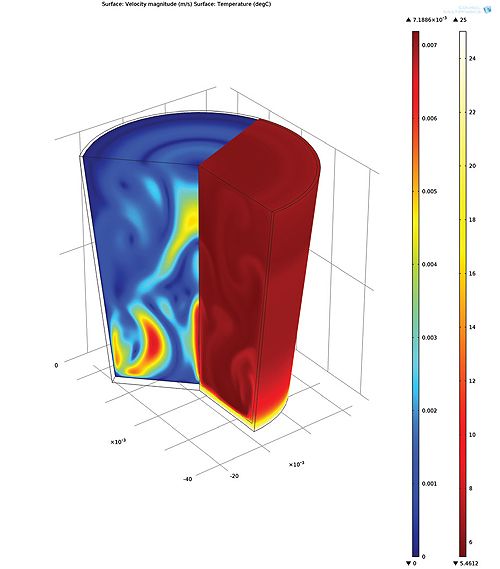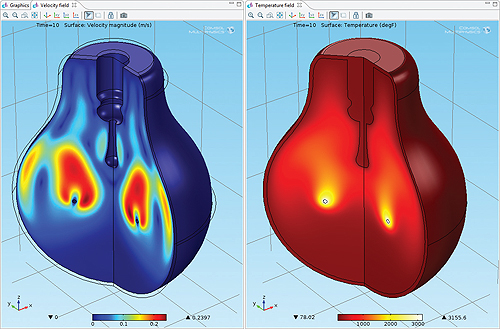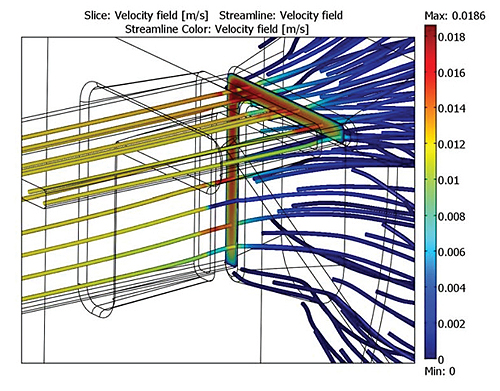by Evan Yares, Senior Editor & Analyst, Software
In 1964, NASA undertook a review of its structural dynamics research program. At the time, its research centers were each separately developing structural analysis software to meet their own specific needs. The review recommended that a single generic FEA (finite element analysis) program should be developed, to simulate a broad range of structural problems. It was from this decision that NASTRAN, the NASA Structural Analysis program, ultimately came to be.
While NASTRAN has grown in capabilities over the years, when it first came out it was designed with the limitations of contemporary computers in mind. It could solve static, dynamic, and heat transfer problems in structural physics, but it ignored any physical complexities in a problem that fell outside these domains.
For many engineering problems, structural analysis alone can provide a good enough first approximation. In some cases, where non-structural physical effects are important, it may be sufficient to account for them through boundary conditions. Yet, there are a surprising number of problems where these simplifications may not be good enough. For these problems, the solution is multiphysics simulation.
To understand the significance of multiphysics, just take a moment to look around you. Many of the everyday things you might see represent multiphysics problems. Consider an incandescent light bulb. To analyze its temperature characteristics requires modeling energy transport—through conduction, radiation, and convection—coupled with momentum transport induced by density variations in the Argon gas in the bulb. It’s inherently a multiphysics problem.
Or, consider an aluminum extrusion. Modeling the extrusion process requires coupling non-Newtonian fluid flow with heat transfer from the internal friction of the moving material. By adding structural mechanics to the simulation, it’s possible to determine the stress in the extrusion die due to fluid pressure and thermal loads. Based on the results from the simulation, the die’s physical parameters and operating conditions can be optimized.

This COMSOL Multiphysics simulation shows the temperature distribution in a glass of water as a function of isothermal flow and heat transfer.
Even something as simple as a glass of water represents a multiphysics problem. Set a cold glass of water on a table, and let it warm up to room temperature. You can model this process by coupling non-isothermal flow with heat transfer. While this might seem at first consideration to be a trivial example, free convection can be an important factor in fermentation processes, casting, and biochemical reactors.
Is every problem a nail?
Abraham Maslow is reputed to have once said, “If you only have a hammer, you tend to see every problem as a nail.”
In the realm of simulation software, it might be said that if you only have structural analysis software, you tend to only see structural analysis problems. Yet, in truth, there is no such thing as a structural analysis problem. All problems arising from natural phenomena are multiphysics.
At the COMSOL Conference 2012, William Vetterling, from ZINK Imaging, talked about his company’s use of COMSOL Multiphysics.
ZINK has developed a unique imaging technology enabling full color digital printing without the need for ink cartridges or ribbons. At the heart of the technology is a multilayer coated paper, which looks like regular white photo paper before printing. Heat from a thermal printhead in a ZINK-enabled device activates the color-forming chemistry within the ZINK Paper.
ZINK first started using COMSOL Multiphysics to calculate the heat flows that allowed them to select full 3D color in a coated medium using a combination of temperature and time pulse patterns.

Determining the temperature distribution in a lightbulb requires considering both energy transport and momentum transport. This simulation was run with COMSOL Multiphysics.
Vetterling pointed out that one of the major challenges ZINK faced in bringing their technology to market was the media coating process. ZINK Paper has a dozen layers, including 3 dye layers, and each of these layers must be both uniform, and of an exact thickness, in order to generate consistent colors.
To make production of the ZINK media commercially viable, many layers must be coated at a time. To do this, ZINK engineers designed a custom coating machine. In this machine, each of the coatings, in liquid form, are flowed down a ramp, where they stack up into a single flow. This flow then cascades as a curtain (or waterfall, if you prefer) onto a quickly moving substrate web, which then moves through a series of forced air drying plenums, and, finally, is wound onto a spool.
The coating process presented some significant challenges to ZINK’s engineers. First, in order to get accurate and consistent layer thicknesses, it was necessary to control the flow rate, viscosity, and temperature of the liquid coating streams across the width of the coater. Next, the liquid coating curtain had to be electrostatically drawn to the coating drum to prevent air entrainment between the coating and the media web. In the drying plenums, the force of the airflow against the media had to be controlled, to avoid causing thickness variations in the coating. At the winding station, pressure and tension variations had to be analyzed, to avoid conditions that would lead to the media “cinching” on the roll. And, when unrolling the media, triboelectric static charge had to be controlled to prevent visible coating artifacts.

Velocity field and streamlines at a profile section of an aluminum extrustion die. A proper design should ensure that different parts of the profile travel at the same speed. This simulation was run with COMSOL Multiphysics, coupling non-Newtonian fluid flow with heat transfer and structural mechanics.
Each one of these challenges required multiphysics simulation. And each one was solved by ZINK engineers using COMSOL Multiphysics. After all the media coating challenges were worked out, ZINK used COMSOL Multiphysics to analyze and optimize their printer designs—for example, calculating how the heat generated by a print head ends up being distributed over a printer’s case.
Developing the ZINK imaging process required innovations in chemistry, engineering, physics, image science, and manufacturing, and generated a portfolio of more than 180 patents and patents pending. It wouldn’t have been possible without multiphysics simulation.

ZINK Imaging’s phase-change dyes and multicoated media enable ink-free printing in devices such as the Polaroid PoGo instant mobile printer. ZINK Imaging first started using COMSOL Multiphysics to calculate the heat flows in print heads. Over time, they discovered that many of the problems they faced in productizing their technology required multiphysics simulation.
Mainstream multiphysics
Multiphysics simulation used to be something exotic. But not anymore. ADINA, Altair, ANSYS, Autodesk, CD-Adapco, ESI Group, LSTC, MSC, NEi, Siemens PLM, and SIMULIA all support multiphysics (though in varying ways).
But it’s arguably COMSOL that has done the most to drive multiphysics into the mainstream of simulation. It has done this by supporting a wide variety of physics disciplines, while focusing on reducing the extraneous complexities of running coupled analyses. In short, smart people can use COMSOL Multiphysics to do interesting analyses without having to learn a lot of arcane software tricks in the process.
COMSOL has also been a pioneer in making high performance computing (HPC) affordable for multiphysics simulation. A single floating network COMSOL Multiphysics license can be used to run an unlimited number of computational nodes in parallel. And, if you don’t happen to have an HPC cluster laying about, COMSOL supports using Amazon’s EC2 cloud computing infrastructure.
Still Evolving
The simulation software market is nowhere close to being static. (Pun intended.) It’s reasonable to expect simulation software vendors to continue expanding their multiphysics capabilities, and to work towards closer coupling between physics disciplines. This will pay off handsomely over the long term, as computing power continues to become cheaper and more available. And as users realize they can tackle increasingly difficult simulation problems.
COMSOL
www.comsol.com
ZINK Imaging
www.zink.com
Filed Under: Software • simulation, ENGINEERING SOFTWARE





Tell Us What You Think!